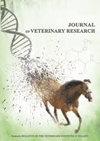An evaluation of dogs’ exposure to benzophenones through hair sample analysis
IF 1.3
3区 农林科学
Q2 VETERINARY SCIENCES
引用次数: 0
Abstract
Benzophenones (BPs) are used in various branches of industry as ultraviolet radiation filters, but they pollute the natural environment, penetrate living organisms, and disrupt endocrine balance. Knowledge of the exposure of domestic animals to these substances is extremely scant. The aim of the study was to investigate long-term exposure of companion dogs to BPs and relate this to environmental factors. Hair samples taken from 50 dogs and 50 bitches from under 2 to over 10 years old were analysed for BP content with liquid chromatography–tandem mass spectrometry. The results revealed that dogs are most often exposed to 2-hydroxy-4-methoxybenzophenone (BP-3) and 4-dihydroxybenzophenone (BP-1). Concentration levels of BP-3 above the method quantification limit (MQL) were noted in 100% of the samples and fluctuated from 4.75 ng/g to 1,765 ng/g. In turn, concentration levels of BP-1 above the MQL were noted in 37% of the samples and ranged from <0.50 ng/g to 666 ng/g. Various factors (such as the use of hygiene and care products and the dog’s diet) were found to affect BP concentration levels. Higher levels of BP-3 were observed in castrated/spayed animals and in animals that required veterinary intervention more often. The results obtained show that the analysis of hair samples may be a useful matrix for biomonitoring BPs in dogs, and that these substances may be toxic to them.通过毛发样本分析评估狗接触二苯甲酮的情况
二苯甲酮(BPs)作为紫外线辐射过滤器被广泛应用于各行各业,但它们会污染自然环境、渗透到生物体内并破坏内分泌平衡。有关家养动物接触这些物质的知识极少。这项研究的目的是调查伴侣犬长期接触溴化联苯的情况,并将其与环境因素联系起来。 研究人员从 50 只狗和 50 只母狗(年龄在 2 岁以下到 10 岁以上)的毛发中提取样本,采用液相色谱-串联质谱法对其中的苯并芘含量进行了分析。 结果显示,狗最常接触的是 2-羟基-4-甲氧基二苯甲酮(BP-3)和 4-二羟基二苯甲酮(BP-1)。在 100%的样本中,BP-3 的浓度水平都超过了方法定量限 (MQL),波动范围从 4.75 纳克/克到 1,765 纳克/克不等。而在 37% 的样品中,BP-1 的浓度水平超过了方法定量限 (MQL),范围从 <0.50 纳克/克到 666 纳克/克不等。研究发现,各种因素(如卫生和护理产品的使用以及狗的饮食)都会影响 BP 的浓度水平。在被阉割/绝育的动物和更经常需要兽医干预的动物中,BP-3 的水平较高。 研究结果表明,毛发样本分析可能是对狗体内溴化联苯进行生物监测的有效方法,而且这些物质可能对狗有毒。
本文章由计算机程序翻译,如有差异,请以英文原文为准。
求助全文
约1分钟内获得全文
求助全文
来源期刊

Journal of Veterinary Research
Veterinary-General Veterinary
CiteScore
0.90
自引率
5.60%
发文量
58
审稿时长
18 weeks
期刊介绍:
Journal of Veterinary Research (formerly Bulletin of the Veterinary Institute in Pulawy) is a quarterly that publishes original papers, review articles and short communications on bacteriology, virology, parasitology, immunology, molecular biology, pathology, toxicology, pharmacology, and biochemistry. The main emphasis is, however, on infectious diseases of animals, food safety and public health, and clinical sciences.
 求助内容:
求助内容: 应助结果提醒方式:
应助结果提醒方式:


